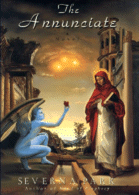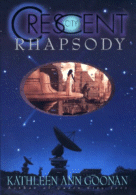Fantasy/SF Book Reviews
by Editor
The Annunciate by Severna Park
Eos, Nov., 1999Hardcover, 294 pages
ISBN: 0380977370
Ordering information:
Amazon.com.
 Eleven inhabited planets orbit each of the three
stars of the ThreeSys star system.
The society of the system is literally falling
apart. A caste system of sorts has developed over
time, consisting of the Meshed, the Jacked and the
Jackless. The Meshed are the elite; they are
neurally linked to a sensory and information network
which runs throughout all the worlds. Consequentially,
the Meshed have great power over their environment.
The Jacked have a standard computer interface, and the
Jackless are the untouchables -- they have no access
to information at all, other than what they pick up with
their five senses. The Jacked and the Jackless have overthrown
their rulers, and very few Meshed survived. But three
Meshed did survive. The trio make an incredibly
addictive drug called Staze which they sell to people
in the name of maintaining the peace. But they stumble
onto an alien intelligence which moves between virtual
and real worlds with no trouble, and intends to enter the
ThreeSys system as a newborn child. Is the new creature really
the Chosen One who will deliver humans into a brave new world,
or is it just a predator who will destroy mankind once and for all?
Eleven inhabited planets orbit each of the three
stars of the ThreeSys star system.
The society of the system is literally falling
apart. A caste system of sorts has developed over
time, consisting of the Meshed, the Jacked and the
Jackless. The Meshed are the elite; they are
neurally linked to a sensory and information network
which runs throughout all the worlds. Consequentially,
the Meshed have great power over their environment.
The Jacked have a standard computer interface, and the
Jackless are the untouchables -- they have no access
to information at all, other than what they pick up with
their five senses. The Jacked and the Jackless have overthrown
their rulers, and very few Meshed survived. But three
Meshed did survive. The trio make an incredibly
addictive drug called Staze which they sell to people
in the name of maintaining the peace. But they stumble
onto an alien intelligence which moves between virtual
and real worlds with no trouble, and intends to enter the
ThreeSys system as a newborn child. Is the new creature really
the Chosen One who will deliver humans into a brave new world,
or is it just a predator who will destroy mankind once and for all?
Severna Park, author of Hand of Prophecy, explores the worlds of nanotechnology, drug addiction and human emotion in her latest work of literary SF. Park excels at taking relationships apart and seeing what makes them work -- or not work, as the case may be. The protagonist of the story is Eve, a young woman who has spent her life under the tutelage of the manipulative and brilliant Anne Marie. Eve's struggles to become her own person are the centerpiece of the book and hold it together, even when the plot becomes a bit abstruse. Park's writing is lyrical and literate; her prose conjures up the most amazing new worlds and ideas. The Annunciate is a fascinating and enigmatic work which will linger in your thoughts long after you've finished reading.
Crescent City Rhapsody by Kathleen Ann Goonan
Eos, Feb., 2000.Hardcover, 430 pages.
ISBN: 0380977117.
Ordering information:
Amazon.com.
 When a powerful electromagnetic pulse (or EMP) hits
the Earth from outer space, communications satellites,
computers and electronics all over the world
are blacked out. The pulses keep coming every
couple of months or so, setting the stage for a
complete change of Earth's society, as scientists
turn to nanotechnology and biology-based science
to restore communications and infrastructure to
a world badly damaged by the EMPs. Meanwhile,
Zeb Aberly, a brilliant astronomer who is on
medication for bipolar disorder, has discovered
an alien message in the EMPs. Zeb is forced to
go underground when government agents
want to keep Zeb from sharing his findings with
the world. Without access to his medication, Zeb
swings from deep depression to manic highs
in which he can do incredible work on his
theories about the source and meaning of the EMPs.
The evolution of our society is also told from
the point of view of Marie Laveau,
a brilliant and wealthy descendant of the famous
voodoo priestess who has her body regenerated
after she is murdered; a young Japanese
scientist who steals the specs for the Universal
Assembler, a nanotechnology device which could
destroy our entire world; and of several of the
children born at the start of the EMPs who are
exhibiting some very strange symptoms -- to the
alarm of the general populace.
When a powerful electromagnetic pulse (or EMP) hits
the Earth from outer space, communications satellites,
computers and electronics all over the world
are blacked out. The pulses keep coming every
couple of months or so, setting the stage for a
complete change of Earth's society, as scientists
turn to nanotechnology and biology-based science
to restore communications and infrastructure to
a world badly damaged by the EMPs. Meanwhile,
Zeb Aberly, a brilliant astronomer who is on
medication for bipolar disorder, has discovered
an alien message in the EMPs. Zeb is forced to
go underground when government agents
want to keep Zeb from sharing his findings with
the world. Without access to his medication, Zeb
swings from deep depression to manic highs
in which he can do incredible work on his
theories about the source and meaning of the EMPs.
The evolution of our society is also told from
the point of view of Marie Laveau,
a brilliant and wealthy descendant of the famous
voodoo priestess who has her body regenerated
after she is murdered; a young Japanese
scientist who steals the specs for the Universal
Assembler, a nanotechnology device which could
destroy our entire world; and of several of the
children born at the start of the EMPs who are
exhibiting some very strange symptoms -- to the
alarm of the general populace.
Crescent City Rhapsody is the third book in the Nanotech Cycle, started with Queen City Jazz and Mississippi Blues. It is a prequel to the other two books in the series, and explains how our world became the nanotechnology-based world described in those books. Goonan has an incredible talent for suspense, character development and poetic description which draws the reader in to the story. Although the numerous shifting points of view might seem a bit difficult to follow, the chapter headings such as "Prelude -- swiftly with gravity," "Break with four sections" and "Divine Horsemen Glissando" give the clues as to the relevance of the chapter in the overall context of the story, which is treated as a musical composition. In any event, Goonan neatly ties all the threads of the story together by the end of the book. With a breathtaking scope and imaginative and inventive ideas, Crescent City Rhapsody is as complex and beautiful as the perfect jazz melody. Highly Recommended.
--Claire E. White
Fantasy/SF Reviews
Page One | Page Two
Return to the April 2000 issue of The IWJ.
More from Writers Write
